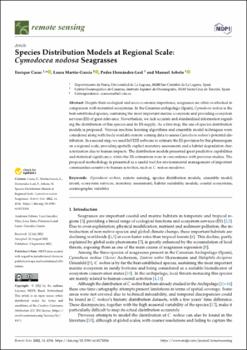Species Distribution Models at Regional Scale: Cymodocea nodosa Seagrasses
Date
2022Abstract
Despite their ecological and socio-economic importance, seagrasses are often overlooked in comparison with terrestrial ecosystems. In the Canarian archipelago (Spain), Cymodocea nodosa is the best-established species, sustaining the most important marine ecosystem and providing ecosystem services (ES) of great relevance. Nevertheless, we lack accurate and standardized information regarding the distribution of this species and its ES supply. As a first step, the use of species distribution models is proposed. Various machine learning algorithms and ensemble model techniques were considered along with freely available remote sensing data to assess Cymodocea nodosa’s potential distribution. In a second step, we used InVEST software to estimate the ES provision by this phanerogam on a regional scale, providing spatially explicit monetary assessments and a habitat degradation characterization due to human impacts. The distribution models presented great predictive capabilities and statistical significance, while the ES estimations were in concordance with previous studies. The proposed methodology is presented as a useful tool for environmental management of important communities sensitive to human activities, such as C. nodosa meadows.






